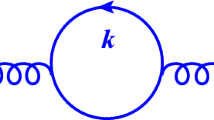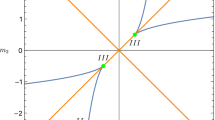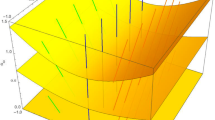Summary
A condensation (spontaneous breakdown of a symmetry group) gives rise to gauge fields associated with an eventually unbroken subgroup. A multiple condensation can establish an associated proliferated set of gauge fields. I interpret the effective electroweak gauge and Higgs field sector as a consequence of a dynamical breakdown cascadeSL 2,C⊳SU 2⊳U 1 and set up a framework for an explicit determination of the induced gauge field properties.
Riassunto
Una condensazione (rottura spontanea di un gruppo di simmetria) dà luogo a campi di gauge associati con un sottogruppo possibilmente non infranto. Una condensazione multipla può stabilire un gruppo associato con proliferazioni di campi di gauge. S'interpreta il settore dei campi di Higgs e di gauge elettrodebole effettivo in conseguenza di una caduta di rottura dinamicaSL 2,C ⊳SU 2⊳U 1 e si forma un sistema per una determinazione esplicita delle proprietà dei campi di gauge indotti.
Similar content being viewed by others
References
For references,P. Langacker:Phys. Rep.,72, 185 (1981).
For references,J. Wess andJ. Bagger:Supersymmetry and Supergravity (Princeton University Press, Princeton, N. J., 1983).
For references:H. Harari: inParticles and Fields II (Banff Summer Institute, 1981), edited byA. Capri andA. Kamel (New York, N. Y. and London, 1983).
S. L. Glashow:Nucl. Phys.,22, 579 (1961);A. Salam andJ. C. Ward:Phys. Lett.,13, 168 (1964);S. Weinberg:Phys. Rev. Lett.,19, 1264 (1967).
P. Q. Hung andJ. J. Sakurai:Nucl. Phys. B,143, 81 (1978);J. D. Bjorken:Phys. Rev. D,19, 335 (1979).
S. Weinberg:Phys. Rev. Lett.,18, 507 (1967);Phys. Rev.,166, 1568 (1967);A. Salam andJ. Strathdee:Phys. Rev.,184, 1750 (1968).
H. Saller: MPI-PAE/PTh 83/83.
H. Saller: MPI-PAE/PTh 5/84.
H. Saller:Nuovo Cimento,124, 349 (1972).
Y. Nambu andG. Jona-Lasinio:Phys. Rev.,122, 345 (1961);124, 246 (1961).
H. P. Dürr andH. Saller:Phys. Lett. B,84, 336 (1979);Nuovo Cimento A,53, 469 (1979);Phys. Rev. D,22, 1176 (1980).
J. Bardeen, L. N. Cooper andD. R. Schrieffer:Phys. Rev.,108, 1175 (1957).
H. Saller:Nuovo Cimento A,71, 17 (1982);76, 663 (1983);77, 214 (1983).
H. P. Dürr andN. J. Winter:Nuovo Cimento A,70, 467 (1970).
Author information
Authors and Affiliations
Additional information
Traduzione a cura della Redazione
Rights and permissions
About this article
Cite this article
Saller, H. Composite gauge fields from nonlinear realizations. Nuov Cim A 86, 231–258 (1985). https://doi.org/10.1007/BF02902550
Received:
Published:
Issue Date:
DOI: https://doi.org/10.1007/BF02902550




